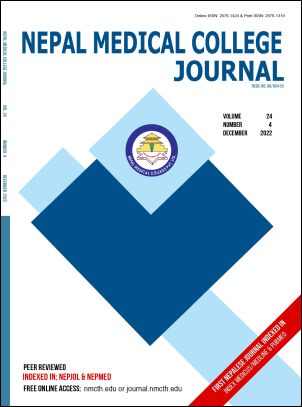Up-to-date Immunization Coverage among Infants Attending a Clinic at a Tertiary Hospital During the Second Wave of COVID-19 Pandemic in Kathmandu, Nepal
DOI:
https://doi.org/10.3126/nmcj.v24i4.50589Keywords:
Infant immunization, up-to-date status, COVID-19, NepalAbstract
This study aimed to evaluate the utilization and quality of routine immunization (RI) services at a tertiary hospital during the second wave of the COVID-19 pandemic period. An observational analytical study was carried out in the Immunization Clinic of a tertiary hospital in Kathmandu, Nepal. The infant cohort was enrolled over a period of 4 months and followed up for a year (April 2021 to August 2022). Up-to-date immunization (UTD) status, overall and vaccine specific drop-out rates were quantified and reasons for missed or delayed doses were elicited from caregivers. An infant who received BCG, 3 doses of Pentavalent (DPT-HEPB-HIB) and OPV containing vaccine, one dose of fractional IPV, 2 doses of Rotavirus vaccine, 3 doses of PCV and first dose of Measles-Rubella (MR1) vaccine prior to their first birthday was categorized as UTD. Dropout rates between early and later vaccine doses were defined as the percentage of children that started their immunization series, but did not complete it for some reason. Among 227 infants (44.1% female) enrolled in the study, about three-fourths (74.5%, 95% CL 68.3% to 80.0%) were identified as UTD. Among UTD infants (n=169), two-thirds of the infants (65.1%, 95% CL 57.4% to 72.3%) had received the vaccines at the recommended age milestones. Overall dropout rate (BCG-MR1) was about 19% with highest dropout between the first and third Pentavalent dose (10%). Maximum delay was seen for MR1 vaccine. Common reasons for missed or delayed visits were that the infant received vaccine at another health facility, or the infant was ill, caregivers had travelled to village/maternal home or were busy. In conclusion, three-fourths of the infant cohort had received all of the recommended vaccines as per the National immunization schedule at our immunization clinic. However, one third had delayed their visits to the clinic. While routine immunization reporting looks at the number of vaccine doses that have been administered at an immunization clinic, this study has documented a sustained utilization of RI services during the second wave of the pandemic period. The lower dropout rate for pentavalent vaccine indicates a qualitative improvement in RI services at the tertiary hospital. However, an ongoing scrutiny of immunization data recording with a progression to digital health records and provision of timely reminders to caregivers may further help to strengthen RI services at the institutional level.
Downloads
Downloads
Published
How to Cite
Issue
Section
License
Copyright (c) 2022 Nepal Medical College Journal

This work is licensed under a Creative Commons Attribution 4.0 International License.
This license enables reusers to distribute, remix, adapt, and build upon the material in any medium or format, so long as attribution is given to the creator. The license allows for commercial use.




